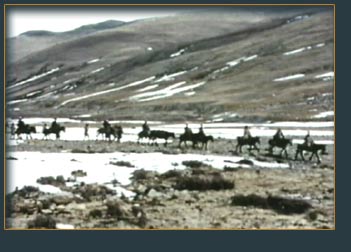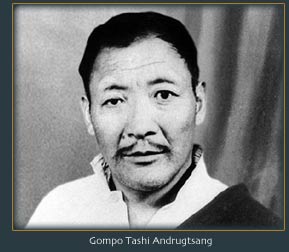|
|
 |






Chushi Gangdruk – Four Rivers Six Ranges
Between 1955 and 1956, the Chinese occupation forces in Eastern Tibet began to impose socialist reforms in the provinces of Amdo and Kham. These included collectivization, measures to settle nomads, active discouragement of religious practice, and the arrests and even murders of uncooperative tribal chieftains and lamas. Not surprisingly, these measures led to widespread resentment and sporadic uprisings. Nomads, farmers, traders and monks joined forces and their monasteries became the focal points of the resistance. The bombing and subsequent destruction of the famous monasteries of Lithang and Chatreng in Kham in early 1956 revealed the full intention of the Chinese to control and subjugate their newly conquered territory at any cost and led to an exodus of Khampas to Lhasa.
In the capital, the Tibetan Government maintained an uneasy alliance with the Chinese military command but stories from fleeing Khampa refugees recounting the atrocities being committed in Eastern Tibet soon began to spread. Several prominent Khampa traders were based in Lhasa and they resolved to act. Led by Gompo Tashi Andrugtsang, a respected and charismatic patriarch from Lithang, they organized a performance of rituals for the long life of the Dalai Lama on July 4th, 1957. This symbolic event catalyzed the formation of an underground resistance movement, Chushi Gangdruk (Four Rivers Six Ranges - referring to the traditional name of the province of Kham).
Gompo Tashi elicited the help of an émigré Tibetan group in India, that included the Dalai Lama's elder brother Gyalo Thondup. Gyalo Thondup and his brother, Thubten Jigme Norbu, had already initiated contact with the CIA. As a result, six young Khampas who had been sent to India by Gompo Tashi became the first batch of Tibetans to be trained by the Americans. Two of these men were subsequently parachuted into Central Tibet and met up with Gompo Tashi in Lhasa in early 1958. Equipped with wireless equipment, they kept the CIA informed about Gompo Tashi's plans
By the summer of 1958, several thousand members of the Chushi Gangdruk had gathered in Lhokha in southern Tibet. Gompo Tashi decided that the time was right to move out of Lhasa and to formally launch military actions against the Chinese. The two CIA-trained radio operators accompanied him to Lhokha where, in an impressive ceremony, the resistance movement was renamed Tensung Danglang Magar (the Voluntary Force for the Defense of Buddhism) to reflect their pan-Tibetan aspirations. Led by Gompo Tashi, the resistance launched multi-pronged guerrilla attacks against the Chinese and soon gained control of a large swathe of Southern Tibet. Their successes were radioed back to the CIA, which made its first arms drop to the guerrillas in July 1958. A second arms drop followed in February 1959.
In March 1959, the situation in the capital had deteriorated. The Chinese military commander invited the Dalai Lama to attend a dance performance at his headquarters on the condition that he came unaccompanied by bodyguards. This proved to be the spark that erupted into a full-scale uprising. The invitation was widely accepted as a ploy to kidnap the Dalai Lama and thousands of Lhasa citizens gathered outside his summer palace, determined to physically prevent him from attending the show. With great reluctance, their leader decided that his only option was to flee. On the evening of March 17th, the Dalai Lama, disguised as a soldier, left his palace under the cover of darkness with a small entourage. Members of Chushi Gangdruk were alerted of his plans and immediately met the escape party a short distance from Lhasa and escorted them through guerrilla-held territory. After a brief stop in southern Tibet, the Dalai Lama and his group crossed over into India on March 30, 1959. |





